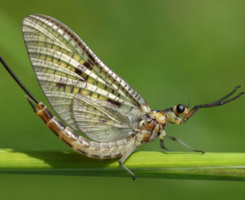Clay-eating
as one of the forms of geophagy is well known and documented in many animals (for
more data, see Dietary Clay Boilies. Natural product number one in the ethical angling world). Unfortunately, next to nothing is
known about clay-eating in fish in the nature (in particular, Ms. Ulli Limpitlaw does not
report such cases: personal communication).
Some our
observations on indirect clay-eating in fish (in clayey localites of the Goryn
river and other right affluents of the Pryp’yat river, Ukraine, beginning from the 1970s)
are given below.
Among
various clayey localities in the foregoing region, those localities that are
colonized by the burrowing invertebrates, such as maylies Ephemeroptera (in
particular, Ephemera vulgata), with
the accompanying microfauna, are most attractive for fish. Localities of this
type are easily detected on the above-water (dried) and underwater clayey or
clayey-carbonate grounds dotted with the numerous burrows of mayfly larvae. Cyprinids
(about 15 species, except limnophilic species), percids (such as perch, Perca fluviatilis, sander, Stizostedion luciopera, and Don ruffe, Gymnocephalus acerina) as well
as juvenile pike, Esox lucius, wels,
Silurus glanis, and burbot, Lota lota, constantly keep these places. Judging by the
compostion of their intestines, larvae E.
vulgata are the main component (up to 90-95 weight percent in benthivorous cyprinids)
of their diets. Large benthivorous cyprinids, such as bream, Abramis brama, and others, can dig the
clayey and (harder) clayey-carbonate grounds unaidedly: in our context,
searching for the larvae, they can ingest the clay. Other fish explore actively
and nibble the crumbling pieces of the clayey bank or feed in the windy
weather, when the waves break up the clay
ground (with the characteristic muddy trails) and
wash the larvae.

Fresh
chunks of the burrowing clay, placed purposely at the closely spaced sites of
the sandy shallow (30-50 cm depth), attract juvenile cyprinids, like ever-present
roach, Rutilus rutilus, and others,
with an intensive nibbling.
Besides
the general observations, interesting results have been obtained with the assistance of
express pair comparisons of the olfactory preferences for the different clays.
Of the two balls (4 cm diameter, equal color) made, one, of the fresh burrowing
clay and, the other, of the same but old, sun-dried clay (collected at the
shore) and placed at the sandy shallow at the 30 cm distance each from other fish
have prefered the first (the total number of pair tests n = 12, fixing the
first nibble, sign test, P < 0.05).
The
olfactory attractivness of balls made of the fresh burrowing clay must be
determined, in the first turn, by the exometabolites of live E. vulgata larvae. At high
...
Read more »




